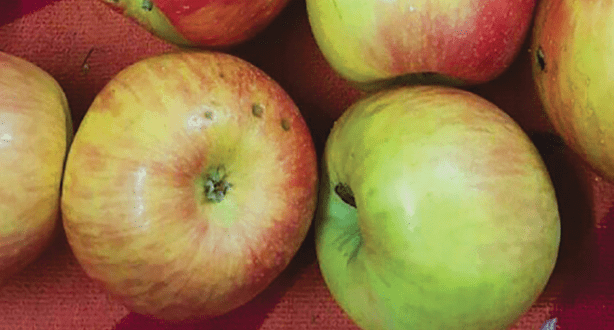

Mar 17, 2020Research seeks suppression of bitter pit
Focusing on the early season may help to moderate the “terrible scourge” of bitter pit in Honeycrisp apples, according to a tree fruit specialist with Cornell Cooperative Extension’s Eastern New York Commercial Horticulture Program.
Research done in New York state between 2016 and 2018 showed up to a 50% suppression of bitter pit with use of the growth retardant Apogee at the “pink” – or open cluster – stage of development, reports Daniel Donahue, an Extension associate with Cornell in Highland, New York. Carefully timed application of calcium sprays may be of further benefit.
Since bitter pit, with its dark, indented spots on the fruit surface and cork-like tissue underneath, appears to be related to a lack of available calcium in the apple at the correct time, “we want to favor movement of calcium early on,” Donahue said in a presentation at the Washington State Tree Fruit Association’s Annual Meeting & Northwest Horticultural Expo in December in Wenatchee, Washington.
Research in 2016-2018 showed that bitter pit can have great variability, affecting from “zero to about 71%” of Honeycrisp apples studied on 36 orchard blocks in the Champlain and Hudson regions of New York state.
“We found that in those 36 blocks, the ratio of magnesium to calcium was positively correlated with bitter pit incidence,” Donahue said. “There tended to be more magnesium and less calcium” in affected apples.
“Calcium is important for strength of cell walls and cell membranes,” he later emphasized to the Fruit Growers News.
An early treatment with Apogee makes a difference, perhaps “maximizing movement of calcium,” or helping to “adjust the hormonal balance in the plant to favor xylem development. Why it works is not clear.”
“Statistics are hugely important in research,” Donahue said. And, with the Honeycrisp apples studied between 2016 and 2018, the numbers were indeed striking. In 2016, while the control trees had 44% bitter pit, the trees treated with Apogee at pink stage had only 25.6% after 45 days of regular storage. In 2017, a “lighter bitter-pit year,” control trees had an 8.4% affliction, while treatment with Apogee at pink stage resulted in a 4.7% rate, after an extended 53 days of routine storage.
In 2018, these numbers compared at 37.6% with control apples and 19.1% for trees receiving Apogee at pink stage, after 48 days of regular storage. More than 8,000 individual apples were studied.
“We’re getting somewhere around about 50% suppression of bitter pit,” Donahue said. “It suggests that there’s a real timing issue with Apogee.” Later applications of Apogee “do not help, and in two out of three years, actually made bitter pit worse.”
To get a true picture of bitter pit incidence, it’s necessary to look at apples after a period of storage. “Bitter pit will express generally at least 30 days into storage,” Donahue said.
This is why it’s impossible for a grower to gauge the scope of the problem by simply going through the orchard and looking at the fruit.
For the Cornell research, the apples were examined for exterior signs of bitter pit, counting and determining severity of lesions, then sometimes put back into storage and checked again later.
Ultimately, Donahue hopes that the Cornell research will help to provide orchardists with testing guidelines to determine from which orchard blocks apples are suited to be put into storage and which should be made available right at harvest. By the 2021 growing season, Cornell Cooperative Extension hopes to have initial recommendations ready, he said.
As important as the mere presence of calcium in the apple seems to be when the calcium is present and how it travels through the apple, Donahue added.
“Some apples with seemingly plenty of calcium have bitter pit,” he observed. “It’s maybe not as simple as being short on a vitamin and taking a pill for it.”
Calcium has a “very limited pathway to move” within the apple, he said. “Calcium can’t be floating about with nothing to do.” If this happens, the calcium can simply go into a vacuole where it is stored and inactivated, Donahue said during a panel discussion at the Annual Meeting & Horticultural Expo.
Applying five weekly sprays of calcium chelate (POMA), starting at petal fall, during cell division, may be an additional step toward suppressing bitter pit. In 2017 and 2018, research trials with POMA were done.
“Early calcium and Apogee combined helped,” he noted. “POMA alone also suppressed bitter pit by approximately 45 percent” with the five sprays.
Encouragingly, these research protocols showed “minimal effect on fruit size,” return bloom or fruit set, Donahue noted.
More detailed information on the Cornell research on bitter pit, including thoughts on pruning during the dormant season, may be found in “Recent Research on the Use of Apogee and Early Calcium Sprays to Suppress Bitter Pit in Honeycrisp,” an article by Donahue in the March 2019 Cornell Cooperative Extension newsletter, “Tree Fruit News.”
As research progresses, more specific advice may be available on method and timing of treatments and even which root stocks are best to help control bitter pit. Selection of root stock is believed to be key, although researchers are still trying to determine exactly why this is.
“Rootstock is a major, major factor,” Donahue contends. “B.9 is flat out superior for Honeycrisp. I think it’s an excellent choice.”
Donahue did emphasize that all of his research has been done in New York.
“Here, we don’t see excessive shoot growth. However, in warmer climates, you may have greater shoot extension and hence more competition for calcium among rapidly growing shoots and fruitlets,” he acknowledged.
Cornell’s research on bitter pit will continue through 2020 in more than 115 New York orchards, to further validate and refine the current test results, Donahue said.
— Christine Corbett Conklin, FGN correspondent














